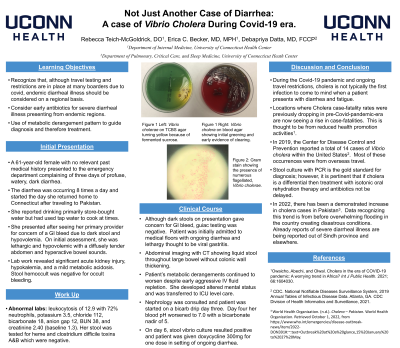Back


Poster Session D - Tuesday Morning
Category: Colon
D0130 - Not Just Another Case of Diarrhea: A Case of Vibrio Cholera During COVID-19 Era
Tuesday, October 25, 2022
10:00 AM – 12:00 PM ET
Location: Crown Ballroom

Has Audio

Rebecca Teich-McGoldrick, DO
University of Connecticut Health Center
Farmington, CT
Presenting Author(s)
Rebecca Teich-McGoldrick, DO1, Erica C. Becker, MD, MPH1, Debapriya Datta, MD2
1University of Connecticut Health Center, Farmington, CT; 2University of Connecticut Heath Center, Farmington, CT
Introduction: Vibrio cholerae is a gram negative, comma-shaped, toxin producing bacteria, which causes large volumes of watery stool leading to dehydration, hypovolemic shock, and metabolic acidosis. Stool culture with PCR is the gold standard for diagnosis. It is pertinent that if cholera is a differential, treatment with isotonic oral rehydration and antibiotics are not delayed. When traveling to endemic or epidemic areas vaccination should be considered. Here we discuss a case of Vibrio cholera infection diagnosed in Farmington, Connecticut in a patient with recent travel back from Pakistan in mid-April 2022.
Case Description/Methods: 61-year-old female with no relevant past medical history presented to the hospital complaining of fatigue and three days of profuse, watery, dark diarrhea occurring eight times daily, starting the day she returned home to Connecticut after traveling in Pakistan. She drank primarily store-bought bottled water but reported some cooking with tap water. She was lethargic and hypovolemic with a diffusely tender abdomen and hyperactive bowel sounds. Lab work was pertinent for leukocytosis, AKI, hypokalemia, and mild metabolic acidosis. Hemoccult stool, Clostridium difficile toxins A&B, Salmonella, Shigella, and fecal leukocyte count were negative. Her course was complicated by altered mental status, worsening AKI, hypokalemia, and metabolic acidosis requiring a bicarbonate drip. Eight days into her admission stool study resulted positive for cholera (Figure 1). Her metabolic derangements were aggressively treated, and her symptoms improved.
Discussion: During the COVID-19 pandemic and ongoing travel restrictions, cholera is not typically the first infection thought of for patients with diarrhea and fatigue. Still, we are seeing cases rise in locations where cholera case-fatality rates were previously dropping in a pre-pandemic COVID-era, thought to be from reduced health promotion activities1. In 2019, the Center for Disease Control and Prevention reported a total of 14 cases of Vibrio cholera within the United States2, most from overseas travel. Thus, it is important to keep a broad differential diagnosis regardless of location even during a time of travel restrictions.
1Owaicho, Abechi, and Olwal. Cholera in the era of COVID-19 pandemic: A worrying trend in Africa? Int J Public Health. 2021; 66:1604030.
2 CDC. National Notifiable Diseases Surveillance System, 2019 Annual Tables of Infectious Disease Data. Atlanta, GA. CDC Division of Health Informatics and Surveillance, 2021.

Disclosures:
Rebecca Teich-McGoldrick, DO1, Erica C. Becker, MD, MPH1, Debapriya Datta, MD2. D0130 - Not Just Another Case of Diarrhea: A Case of Vibrio Cholera During COVID-19 Era, ACG 2022 Annual Scientific Meeting Abstracts. Charlotte, NC: American College of Gastroenterology.
1University of Connecticut Health Center, Farmington, CT; 2University of Connecticut Heath Center, Farmington, CT
Introduction: Vibrio cholerae is a gram negative, comma-shaped, toxin producing bacteria, which causes large volumes of watery stool leading to dehydration, hypovolemic shock, and metabolic acidosis. Stool culture with PCR is the gold standard for diagnosis. It is pertinent that if cholera is a differential, treatment with isotonic oral rehydration and antibiotics are not delayed. When traveling to endemic or epidemic areas vaccination should be considered. Here we discuss a case of Vibrio cholera infection diagnosed in Farmington, Connecticut in a patient with recent travel back from Pakistan in mid-April 2022.
Case Description/Methods: 61-year-old female with no relevant past medical history presented to the hospital complaining of fatigue and three days of profuse, watery, dark diarrhea occurring eight times daily, starting the day she returned home to Connecticut after traveling in Pakistan. She drank primarily store-bought bottled water but reported some cooking with tap water. She was lethargic and hypovolemic with a diffusely tender abdomen and hyperactive bowel sounds. Lab work was pertinent for leukocytosis, AKI, hypokalemia, and mild metabolic acidosis. Hemoccult stool, Clostridium difficile toxins A&B, Salmonella, Shigella, and fecal leukocyte count were negative. Her course was complicated by altered mental status, worsening AKI, hypokalemia, and metabolic acidosis requiring a bicarbonate drip. Eight days into her admission stool study resulted positive for cholera (Figure 1). Her metabolic derangements were aggressively treated, and her symptoms improved.
Discussion: During the COVID-19 pandemic and ongoing travel restrictions, cholera is not typically the first infection thought of for patients with diarrhea and fatigue. Still, we are seeing cases rise in locations where cholera case-fatality rates were previously dropping in a pre-pandemic COVID-era, thought to be from reduced health promotion activities1. In 2019, the Center for Disease Control and Prevention reported a total of 14 cases of Vibrio cholera within the United States2, most from overseas travel. Thus, it is important to keep a broad differential diagnosis regardless of location even during a time of travel restrictions.
1Owaicho, Abechi, and Olwal. Cholera in the era of COVID-19 pandemic: A worrying trend in Africa? Int J Public Health. 2021; 66:1604030.
2 CDC. National Notifiable Diseases Surveillance System, 2019 Annual Tables of Infectious Disease Data. Atlanta, GA. CDC Division of Health Informatics and Surveillance, 2021.

Figure: Vibrio culture on thiosulfate-citrate-bile salts-sucrose (TCBS) agar (left) and on blood agar (right).
Disclosures:
Rebecca Teich-McGoldrick indicated no relevant financial relationships.
Erica Becker indicated no relevant financial relationships.
Debapriya Datta indicated no relevant financial relationships.
Rebecca Teich-McGoldrick, DO1, Erica C. Becker, MD, MPH1, Debapriya Datta, MD2. D0130 - Not Just Another Case of Diarrhea: A Case of Vibrio Cholera During COVID-19 Era, ACG 2022 Annual Scientific Meeting Abstracts. Charlotte, NC: American College of Gastroenterology.

